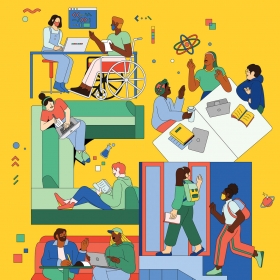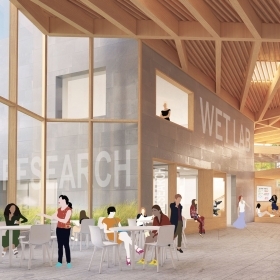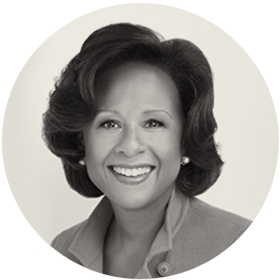The College aims to make STEM accessible to all
A growing range of programs based in the Science Center at Wellesley provide opportunities for students from first-generation, low-income, and underrepresented populations to participate in research and other STEM-related activities.

Posse 1’s time at Wellesley has been bookended by natural disasters. In 2017, Hurricane Harvey trapped the cohort of 10 first-years in Houston, their hometown, and they missed orientation. In 2021, a winter storm cut off power and water to the city just as the Posse Scholars were getting ready to log into their remote classes for spring term. And before that? A global pandemic that hit when many of the students were studying abroad, stranding them around the globe.
None of that has stopped them.
Posse Scholars come to the College via the Posse Foundation, a national nonprofit that has placed some 10,000 students from first-generation, underrepresented, and low-income populations in 63 colleges and universities around the United States. The students receive full tuition scholarships from the institutions that admit them. Wellesley began partnering with Posse in 2017, recruiting a group with an expressed interest in pursuing STEM (science, technology, engineering, and math) degrees.
All of the pioneering members of the College’s first cohort are set to graduate this spring with the class of 2021. “They’re getting into grad school. They’re getting these amazing job offers,” says Senior Instructor in Biological Sciences Laboratory Jocelyne Dolce, who has mentored Posse 1 from their first day on campus. “They’re negotiating salaries. One student has an offer from Genentech in California and Eli Lilly, and she’s going back and forth with both companies at the moment. Another was recently negotiating with MIT Lincoln Labs and Capital One, and she got accepted into Georgia Tech for engineering graduate school.”
Posse 1 may be leaving campus, but their influence will persist after they graduate. And that’s the whole idea.
Through programs like Posse and a commitment to need-blind admission, Wellesley continues to increase the diversity of the student body: Among first-years—the class of ’24—57% are domestic students of color, identifying as African American, Asian American, Latina or Hispanic, Native American, or multiracial, and 19% are the first generation in their families to attend a four-year college. Sixty-three percent of the admitted class of 2025 are domestic students of color, and 21% are first-generation.
Along with a commitment to diversity in the campus population, the College seeks to support underrepresented students who are pursuing STEM majors. Campus research has shown that while African American and Latinx students do enroll in STEM fields, they are less likely to excel or persist in those areas than are students who are white or of Asian descent.
“We’ve done well by the white and Asian population, but we have not done as well by students from low-income or first gen backgrounds, and students from under-resourced high schools,” says Cathy Summa ’83, associate provost and director of the Science Center. “It wasn’t because they weren’t coming to campus; it was because we weren’t providing the kinds of learning environments that enabled all students to thrive.”
Megan Núñez, the Nan Walsh Schow ’54 and Howard B. Schow Professor in the Physical and Natural Sciences, professor of chemistry, and dean of faculty affairs, says, “It’s not about how are the students broken and how do we fix them. Our students are all really smart. And all of them did the most advanced classes in their high schools. There’s no reason that they shouldn’t be succeeding here—that’s in them. And so we have to think about how do we structure their majors? What are the classroom environments like? What is it like for them to be here?”
Changing the Way We Teach
Aware that these students may not have had the academic support other students benefited from in high school, faculty across campus have been adapting their courses to create environments that welcome students from a wide variety of backgrounds.
For example, the physics department revised its curriculum in 2018 to provide a better entry point to the major. Classes use a collaborative learning model for in-person instruction and to help students gain stronger senses of identity as scientists through peer instruction. A physics learning assistant (LA) program connects students who have already taken a particular course with students who are currently enrolled in it.
“We expect that these changes will benefit all of our students,” James Battat, associate professor of physics, told Spotlight on Wellesley, a series of articles on the College’s website. “But physics education research tells us that the changes … have even more significant positive impacts on first-gen students and students of color.”
As recently as 2014, the physics department counted majors in single digits. In the first year after the curriculum changes were implemented, the number jumped to 28, and just under half are first-generation and underrepresented students.
Another effort among faculty has been change-agent training funded by the Howard Hughes Medical Institute (HHMI), as part of the College’s Inclusive Excellence Initiative. Designed to reimagine pedagogy to support all students in the classroom, the program will have touched four cohorts of faculty by June of this year. Jocelyne Dolce was in the first group in 2019. “Almost all Science Center faculty were there,” Dolce says. “We learned lots of techniques to call everybody into conversations in class. Many of us now start our classes saying, ‘Everybody has something to contribute and everyone has something to learn.’ Just verbalizing that has changed the dynamic of how students interact with each other.”
Dolce says the change has been incremental, but the number of faculty, staff, and students who are implementing these approaches continues to expand. By June, 100 faculty and staff will have taken the change-agent training. The College’s senior leadership engaged in a one-day intensive version of the program. And then there are the 40 Posse Scholars, 30 current McNair Scholars (low-income, first-generation, and historically underrepresented groups who are preparing for doctoral study), and others.

‘Students start to see again and again classroom norms that insist all voices are heard, no one gets left behind, group work is equitable, and all members of our community matter.’
“Critical mass starts to make itself noticed when students take classes with multiple faculty members who are change agents, and it reinforces that the values and practices are general to Wellesley and not specific to any one faculty member,” says Núñez, who was instrumental in bringing the change-agent program to campus. “Students start to see again and again classroom norms that insist all voices are heard, no one gets left behind, group work is equitable, and all members of our community matter.”
Núñez adds that these values and methods have started to influence other interactions on campus, including how department and committee meetings are run, as people ask: What do we learn when all voices are heard?
A Culture of Welcome
As a Black woman who holds a Ph.D. in education administration and an M.S. and B.S. in marine science, Ayana McCoy, assistant director of the Science Center, knows the challenges underrepresented students face in persisting in STEM. “We’ve still got a whole lot of work to do. And this work is hard. But when you see students surviving and thriving and going on to grad school, it’s worth it. When they start seeing themselves as scientists, when they start talking about their research, it’s worth it.”
STEM programs have evolved, says Summa, not just to be more inclusive of the students but more inclusive of their experiences.
“If we humanize science, then more people will come to science,” she says, “more people will feel included in science—particularly if we let them ask questions that are relevant to their experience. Science will be better for it because we will have a broader understanding of the world in which we live.”
McCoy says she wants the Science Center to be a home for all students, not just science students. To that end, a couple of giant piano mats and boxes of games and puzzles have been strategically placed in the space.
“I like walking into the data lounge and seeing the diversity of students there,” says McCoy. “When people are lounging and they are laughing and enjoying themselves just being, it makes me happy. I feel like we are doing something right. Some students are still intimidated by the Science Center. I say, ‘Come on in and just make it your space.’”
That’s what Christelle Gilot ’24 has done, even during this pandemic year. A first-generation student from Newark, N.J., Gilot’s initial science class at Wellesley was BIS-CHEM 116. “It combines intro to bio and intro to chem, with two labs every week and class every day,” she says. With a paper due for her writing class, and multiple problem sets to complete, “I was juggling a lot.”
She approached Dean Rebecca Garcia, who directs Wellesley First, which links campus efforts to support first-generation students, students from underrepresented groups, and those from under-resourced backgrounds.
“Dean Garcia always has a solution,” Gilot says. “She said, ‘You can ask for an extension.’ She made me realize that it’s not wrong to ask for more time or more help.”
Gilot’s class projects in BIS-CHEM 116 were designed to be collaborative, Gilot says. “I was always getting help from my peers. And a shout-out to our supplemental instructor, a senior chemistry major, and the writing tutors!”
Gilot wants to major in biochemistry and is taking engineering next term. A favorite spot for studying? The Science Center. “There are classrooms on the first floor that I hang out in. It’s my spot.”
Expanding Opportunities
A growing range of Science Center-based programs provide opportunities for students from first-generation, low-income, and underrepresented populations to participate in research and other STEM-related activities. These include:
- The First-Year Student Research Apprentice Program enables first-years who have little laboratory experience to become apprentices in Science Center faculty labs and build some basic skills and confidence in their ability to participate in research. Students are not required to have prior laboratory experience.
- The Sophomore Early Research Program (SERP) enables sophomores to carry out collaborative research projects with natural science and social science faculty mentors during the academic year. These are considered work-study positions, so students must be work-study eligible. To participate in SERP, students must be one or more of the following: first-generation, low-income/high-need, and/or from an underrepresented racial/ethnic group.
- The HHMI Inclusive Excellence Student Internships are on-campus, academic year internships that encourage students to develop new skills and understanding about science, technology, and teaching. Preference is given to work-study eligible students.
- The Science Center’s paid summer research program is for students interested in doing scientific research with Wellesley faculty members. The program is open to all students with an interest in scientific research, and a science major is not required.
- During the academic year, currently en-rolled students traveling to professional conferences to present their research as first or second authors can apply for travel funds from the Office of the Provost that are managed by the Science Center.
- A new program beginning in fall 2021, with funding from the Clare Boothe Luce Foundation, will provide support for juniors from underrepresented, first-generation, and low-income backgrounds to conduct lab research in the physical sciences with the goal of doing a senior thesis. (Jocelyne Dolce will mentor the first group of students, who are being selected this spring.)
The Path to Graduate School
Another initiative housed in the Science Center is Wellesley’s chapter of the national, federally funded Ronald E. McNair Postbaccalaureate Achievement Program. Now in its third year at Wellesley, the program for underrepresented students is named for the Black astronaut who was a mission specialist on the ill-fated Challenger space shuttle. Its scholars receive summer research funding, attend workshops on graduate admissions and funding, receive GRE training and personal and academic counseling, network with faculty mentors, and attend and present at national and regional conferences. And, like Posse Scholars, participants become part of a community of like-minded peers.
Francelis Morillo Suarez ’21 says the McNair program has helped her stay committed to STEM as she looks to a career in environmental studies. “My journey at Wellesley has been exploring the various environmental topics through my courses and my research,” she says. “I’ve been able to take courses on environmental justice, food and agriculture engineering, environmental chemistry—all these very different focus areas. And next term I’ll be able to take one in environmental health.”
Morillo Suarez, a first-generation student from Lawrence, Mass., says she wasn’t aware of what preparing for advanced study in graduate school entailed. Then she learned about the McNair program. “I hadn’t come to Wellesley thinking that I’d do research, but I am so glad that I decided to apply for the program, because I’ve deepened the knowledge I’ve gained through my courses.”
Her research has looked at the intersection of biology and sustainability and environmental policy. While studying abroad in Italy in 2019, she set up her own research project on food waste.
“I’m really passionate about environmental justice and working collectively on environmental, social, and economic sustainability,” Morillo Suarez says. “A lot of what’s going on in the world today is very interconnected. The best solutions come from collaborating with different people, and people who come from different academic backgrounds or positionalities.”
A Stronger Community for Everyone
Posse Scholars set a strong example of reaching out and including others, says Dolce. “Now we have what we call Posse Plussers, students who go to our Posse Plus retreats and become friends of the Posse Scholars. It has become this large group of students from underrepresented backgrounds that we didn’t see as a cohort of any kind five years ago.”
The result? “The Science Center has become a lot more visibly a community, rather than the students just hovering over their textbooks, which is what it used to be. I think that there’s a conversation happening in our building that I hadn’t thought would happen, truthfully, four or five years ago. And the students are the ones leading that conversation,” says Dolce.
This is not a surprise to Garcia, who says that in her work as a dean with first-gen, low-income, and underrepresented students, “We talk a lot about a cultural wealth model.” The idea is that these students bring significant cultural capital to their new communities. Garcia, herself the first member of her family to graduate from college, says, “Communities of color and marginalized communities have really built [cultural capital] up. That’s what students are bringing with them. They have a good sense of creating community on campus, particularly because they value interdependence.”
They also bring resilience and a passion to make a difference in their communities, she says. “That’s part of their blueprint.”
Catherine O’Neill Grace is senior associate editor of this magazine.


